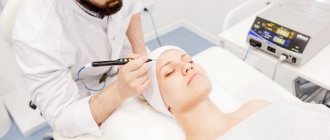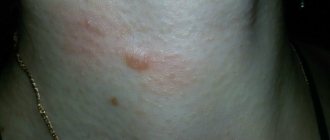Almost every person has at least a few moles on their body. They are benign growths, which in medicine are called nevi. Formations appear on the skin even before puberty.
They can remain on a person’s body throughout his life or disappear unnoticed. There are moles that form in places where they can be touched. Therefore, in order to avoid unpleasant sensations and protect yourself, doctors recommend electrocoagulation of moles.
What is the essence of electrocoagulation?
There are cases when seemingly harmless formations develop into malignant tumors. This can happen due to the influence of many factors, among which a special place is occupied by the effect of sunlight on moles.
Content:
- What is the essence of electrocoagulation?
- About risk factors
- When is electrocoagulation of moles indicated and contraindicated?
- Pros and cons of the procedure
- Mole removal procedure
- Postoperative care
- Possible complications and consequences
Modern medicine has armed itself with various methods of combating unwanted growths that interfere with normal life. The safest treatment methods include electrocoagulation, surgery, laser destruction and radio wave removal. A simple and effective way to protect your own health is electrocoagulation of moles.
The technique is based on the use of high-frequency current discharges, which act as a surgical scalpel. These current discharges make small incisions in the area of the nevus. The tumor is cut off layer by layer.
The device that delivers current discharges is called an electrocoagulator. Electric current affects the desired areas of the skin and prevents bleeding (performing a cauterization function). This technique is considered effective, and with the most minimal risk of infection.
Possibility of unforeseen consequences
Laser correction of moles is one of the safest ways to get rid of nevus, avoiding complications and unforeseen consequences. A beam of directed light radiation literally evaporates the pigmented cells of moles, which is visually manifested by the complete removal of the epidermal formation in just a few minutes. Minimization of negative consequences occurs due to the following objective factors.
- The laser beam acts in a strictly targeted and selective manner, without injuring healthy skin structures, which allows the technique to be used even to remove the smallest nevi in the eyelid area and mucous membranes;
- There is virtually no risk of infection, since the laser exhibits a powerful antibacterial and antimicrobial effect, protecting the wound surface from infection;
- Laser destruction is not accompanied by bleeding or hemorrhage, since during the manipulation process all blood capillaries supplying the body of the mole undergo thermal coagulation;
- The laser activates regenerative processes in the skin, which significantly accelerates wound healing;
- The technique is low-traumatic, which avoids the formation of connective tissue and all the negative consequences associated with this factor.
Despite the safety of the method, it should be borne in mind that before the procedure it is necessary to carefully study the list of contraindications, since the consequences and complications of laser correction most often result from neglect of this list, which includes the following conditions:
- Pregnancy;
- Acute infectious process;
- Oncology of any localization;
- Inflammation in the intended area of laser exposure;
- Period of menstruation in women;
- Immunodeficiency;
- Exacerbation of chronic pathologies;
- Hyperthermia.
About risk factors
Moles on the body need to be monitored so that they do not develop into a serious disease, such as melanoma. Skin cancer is a common cancer that occurs in people of different age groups. In the early stages of the disease, you can begin an effective course of treatment and defeat the disease.
Risk factors influencing the degeneration of a nevus into melanoma: trauma to the neoplasm, constant and prolonged exposure to the sun, hormonal changes, dysfunction of the endocrine system, genetic predisposition. Doctors warn that if the process of nevus degeneration into skin cancer begins, it will not be easy to stop.
You should consult a doctor if you have the following symptoms:
- changes in the size and shape of the nevus;
- intensive growth of education;
- bleeding from a mole;
- wrinkling and peeling of the neoplasm;
- uneven color of the nevus;
- hair loss around the growth.
If you have one or more symptoms, you should seek help from a dermatologist or surgeon. After undergoing a complete diagnosis of the body, the specialist will decide which method is best to remove the growth.
Characteristic
Spider veins are dilations of the capillaries of blood vessels. On the face they appear in the area of the nose and cheeks. Spider veins are also called telangiectasia.
According to studies, more than 90% of the world's population are “owners” of telangiectasia, which, in turn, combines all types of vascular dilatation on the human body.
The name vascular network appeared due to the fact that dilated capillaries become quite noticeable on the body and form the appearance of a mesh. It is worth noting that such expansion of capillaries does not form without reason. This disease mainly affects women in labor and young mothers; telangiectasia can also be a consequence of a disease such as venous insufficiency.
In the course of the studies, it was revealed that the appearance of the vascular network is not affected by any individual factors or diseases. It has become known that those who are susceptible to chronic varicose veins may not have vascular networks on their body. Thus, we can conclude that the vascular network is not the cause or consequence of any individual diseases, it is a separate problem of the body in each specific case and is often caused by hormonal imbalance.
When is electrocoagulation of moles indicated and contraindicated?
The procedure for removing a mole should be prescribed if there are a number of indications. Before prescribing a manipulation, the doctor must make sure of the nature of the formation, why the formation occurred and what factors influenced this process. For malignant degeneration, surgical intervention is most often used.
People for whom nevus causes discomfort and spoils the aesthetic appearance of the body are prescribed an electrocoagulation procedure.
The manipulation does not take much time from the patient and is completely safe. One of the main advantages of the recovery period is the absence of scars on the skin. If the mole is larger than 1 centimeter, it must be removed through surgery. After the operation, stitches are placed and, alas, marks remain on the skin.
Contraindications for electrocoagulation:
- allergies to drugs that are part of anesthesia;
- individual sensitivity to electrical procedures;
- blood clotting disorder;
- malignant neoplasms (in the case of oncology, other treatment methods are used).
Electrocoagulation of moles is a technique that will allow a person to get rid of growths that spoil the aesthetic appeal of the body. Doctors prefer this manipulation because of its safety, accessibility and effectiveness.
What is tumor removal using electrocoagulation?
The Surgitron device was invented and put into mass production in 1973 in the USA, and approved for use in the Russian Federation in 1995. The essence of its action is the emission of high-frequency (3.8-4.0 MHz) radio waves with a certain energy reserve by surgical electrodes with a diameter of only 50-150 microns. Tissue cells, upon contact with radio waves, absorb energy, resulting in the evaporation of intracellular fluid and achieving precision (high-precision) tissue dissection.
Pros and cons of the procedure
Removing nevi using an electrocoagulator is a simple manipulation that has its advantages and disadvantages. If the doctor follows safety precautions during the intervention, then a relapse is unlikely.
The cut growth is sent for histological examination, and the epidermis adjacent to the nevus is removed, thereby minimizing the regrowth of the formation. The advantages also include safety and low cost of manipulation.
The only downside of the operation can be the formation of a scar or scar at the excision site. This is only possible when the procedure is carried out unprofessionally or in case of non-compliance with the recommendations of patients during the rehabilitation period.
Removal of nevi in Israel
Traditionally, in Israel the safest and most effective method of mole removal is used - surgically, using a scalpel. The operation is most often performed under local anesthesia and does not require hospitalization of the patient. The cosmetic skin defect that remains after surgery is practically no different from similar marks after cryodestruction or laser removal of moles. The main advantage of this approach is that as a result of the operation, the doctor receives a tissue sample of the mole, which is then subject to histological testing. When using other methods, the substrate of the mole is “burned out”, and it is not possible to establish its origin, as well as prevent the development of possible consequences.
In Israeli clinics, they approach the removal of nevi very responsibly. An indispensable condition for the operation is subsequent histological examination of the material. Thus, even with the slightest pathological changes in the nevus, timely measures can be taken and the development of possible complications can be prevented.
In Israel there are quite a few specialized departments for the treatment of melanoma. In this regard, the prevention of this disease is given special importance. Careful monitoring of moles, diagnosis of suspicious nevi and timely removal of pathological pigment spots is the priority of Israeli specialists. Modern international protocols are used for treatment.
Mole removal in Israel is carried out in most cases on an outpatient basis. For nevi of atypical localization, hospitalization may sometimes be necessary. For example, removal of an eye nevus is classified as a complex case, and performing this operation requires a surgeon with extensive experience and high qualifications.
The advantage of treating nevi in Israel, in addition to the use of modern surgical techniques, is the highly accurate pathohistological diagnosis of the material. The study of a removed nevus is carried out using many parameters, due to which the likelihood of a diagnostic error is practically reduced to zero.
In case of diagnostically difficult and doubtful cases, in order to avoid errors, the pathohistological sample is additionally sent for examination to another pathologist.
Mole removal procedure
No additional preparation is required for electrocoagulation. The manipulation itself takes from 15 to 30 minutes. First, the doctor does an allergy test for medications. If there are no allergic reactions to medications, you can safely proceed to anesthesia. The patient is given local anesthesia or a special cream is applied to the skin. Next, using the device, the mole is excised layer by layer. At the time of removal, the skin at the site of the growth is cauterized. Cauterization of the epidermis and blood vessels occurs due to exposure to very high temperatures. Electrocoagulation allows you to solve the problem of bleeding, swelling and infections.
During the manipulation, a person will not feel discomfort or unpleasant sensations. The patient may only feel a slight tingling sensation in the area where the nevus is excised. After manipulation, a scab (protective crust) forms in its place. The scab protects against infections from entering the wound and prevents bleeding. The wound healing period varies from 7 to 10 days.
Preparation for the procedure
It doesn’t matter for what reason it is necessary to remove moles with an electric knife, you must undergo an examination before the procedure.
Mandatory indications for excision are:
- location of the nevus in a place of constant friction and pressure;
- increase in size;
- change in shape, clarity of edges;
- bleeding, inflammation, pain.
It is impossible to determine by eye whether a benign growth is present or whether cancer cells are present. It is necessary to conduct a histological examination. The oncologist gives the go-ahead for removal and saves the excised tissue for further medical procedures.
Do not go to beauty salons for the procedure! The cosmetologist does not have the necessary education and after unprofessional intervention melanoma may develop!
The preparation process takes a few minutes:
- local anesthesia is applied using ointment or gel. It will protect the area exposed to current from overheating and prevent burns to healthy tissue;
- the patient is placed on the couch in a comfortable position, allowing access to the nevus.
Postoperative care
To prevent scars from appearing at the site of excision of the formation, you should not neglect the doctor’s recommendations for caring for the wound. The skin must be treated with special antiseptic preparations (hydrogen peroxide or chlorhexidine).
The excision site should be protected from negative external influences, such as sunlight, and the use of cosmetics is prohibited. Also, it is necessary to ensure that moisture does not get on the skin.
It is not recommended to visit solariums, swimming pools, saunas and steam baths until the wound heals. It is advisable to walk outside on sunny days after lunch or in the evening. There is no need to remove the scab yourself; it will fall off on its own after complete healing. If you follow all the rules and recommendations during the recovery period, you can minimize unwanted skin pigmentation and avoid complications.
Causes
The causes of the appearance of spider veins can only be disturbances in the body’s hormonal system; often such “failures” affect women and girls.
Factors influencing the appearance of telangiectasia can be: pregnancy, childbirth, menopause in women, abortion, ovarian cyst. All of the above phenomena stimulate the process of restructuring hormones in the body. Contraceptives can be especially active in this matter, which is why it is recommended to seek advice from specialists before taking them.
In some rare cases, a disease such as telangiectasia may be congenital, especially if there is a family history.










